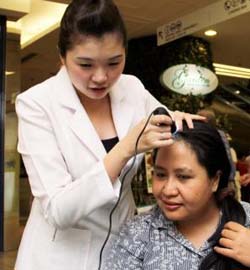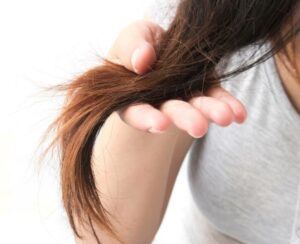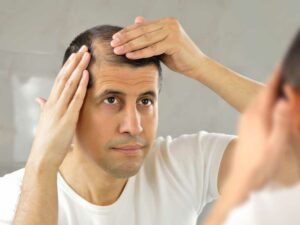 Hair loss is becoming more of a woman’s problem, no thanks to changing lifestyle patterns.
Hair loss is becoming more of a woman’s problem, no thanks to changing lifestyle patterns.
ACTORS Yul Brynner and Telly Savalas were bald, yet attractive. When you spot a man with no hair on the street, you wouldn’t give two hoots but when you see a woman with balding patches, it’s only natural to do a double take.
It’s a rare sight indeed to spot a woman with anything less than her crowning glory, but these days, more and more women are complaining about losing hair.
According to findings by 101 Hair Care, which celebrates its 38th anniversary this year, more women are suffering from hair loss problems compared to males. More alarming is the fact that teenagers and children as young as seven are losing hair as well.
“Women are balding at a faster rate than men,” says Fanny Ling, 101 Hair Care’s nutritionist. “In the past, we saw plenty of male pattern baldness but now due to lifestyle changes, hormonal imbalances arising from stress and post-pregnancy, hair loss has become a woman’s problem.”
Common hair problems are caused by alopecia universalis (abnormality in the immune system), oily scalp, dandruff, as well as male and female pattern baldness.
“Female pattern baldness happens in the parting areas and usually arises during the postnatal period when mothers do not take care of their hair. They listen to their elders and don’t wash their hair for a month. For the Chinese, confinement involves eating a lot of ‘heaty’ stuff, which makes the body temperature rise. This increases the metabolic rate and causes a faster dead skin cycle, more dandruff and oil blockages,” explains Ling.
A normal, healthy person should not lose more than 30 strands of hair daily. If the amount of shedding is more than the growth of baby hair or there is no new growth, or the new hair is growing slower than 0.03mm a day, then it is defined as hair loss.
“With emerging societal trends, lack of nutrition, weather and lifestyle changes, the body is affected, especially the hair. We’ve also discovered new hair loss problems such as demodex, which are parasites living in the scalp. They steal the scalp’s nutrition and damage the cell walls, causing hair loss. After mating, they burrow into the skin, lay eggs, introduce bacteria and infection to the skin,” says Ling.
These mites come from pets, are contagious, and can only be detected by a microscope. One of the obvious signs of mite activity is itching, crawling or tickling sensation on the face and/or scalp. However, a lot of times, there is no itching and most people are not aware they are infested with demodex mites.
She adds, “The solution is to use different tonics and infrared energy to kill the mites. Since they feed on oil, we have to eliminate the oil on the scalp and starve them. We have seen a lot of these cases in the past three years.”
These days, one out of 10 clients are below the age of 12, says Ling, and seven are female.
“Parents of teenagers bring them over because of a condition called trichotillomania, whereby they pluck or tug their hair unknowingly due to shyness, anxiety or inferiority complex. If they keep plucking, the follicle will be damaged and it’ll be hard for the hair to grow back. We have to remind parents to provide encouragement to their children,” says Ling.
Trichologist Rozanna Chung says from the early 90s, more women have been seeking treatment for hair loss. The quick solution was hair replacement or hair rejuvenation.
“The former fell out of favor because it requires a lot of maintenance, money and time. With people being more active nowadays, they don’t have time to do their hair,” says Chung, who used to run a clinic but operates from home now.
The lifespan of a healthy strand of hair is 1,000 days. If you suddenly lose a patch of hair, it could be due to trauma or shock. But if the loss is in the center, chances are its genetic.
“Every one of us goes through a period of hair thinning. The only question is whether it’s reversible or non-reversible. The job of a trichologist is to tell the difference. If you’re destined to look like an egghead like your father, that’s how you’ll look! Science can only go that far,” she states matter-of-factly.
Hair loss is something very emotional, Chung reckons. People occasionally live in denial and allow themselves to fall prey to sales talk.
“It’s also a problem with teens due to popping antibiotics and anti-acne pills, and inadequate sleep. Your hair is the barometer of your health so the first thing I do is to check their lifestyle before examining them physically,” says Chung, who writes for several magazines and speaks on radio shows about hair topics.
“Until ageing takes place, the point of no return is 70 years old. You can fake it till then or wear a hairpiece. I wear a hairpiece sometimes – when I feel the need to look like a Hollywood superstar. No one can tell the difference. It’s like wearing a padded bra. If it makes you feel good, why not!”
Chung has recently created her own line of do-it-yourself shampoo under the RozzKelly banner. The base is a volumizing shampoo and you can add on aromatherapy oil and color protection, according to what you need. The products flew off the shelves and will soon be available online.
Her simple four-step regimen to hair care health includes washing your hair as often as needed, using the right kind of product, not subjecting your hair to unnecessary chemical abuses and looking after your health by not falling sick.
“You must also use a conditioner to smoothen out hair texture but never use it on the scalp. Any good hair care product must be able to be rinsed off with just water. If it leaves a residue, it’s not a good product. I have nothing against natural products but too much of a good thing can also be bad,” concludes Chung.





